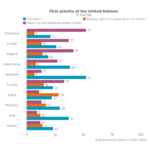Women’s exclusion from the workforce in the Middle East and North Africa (MENA) is a substantial problem. The Middle East has the world’s lowest rates of female labor froce participation — 26 perecent compared to 54 percent worldwide (USAID 2014) — and a gender gap in youth unemployment — 43 percent for females and 25 percent for males (Barnes 2013). Serious problems arise as a result. Low women’s workforce participation has been identified as a cause of political disempowerment (Norris and Inglehart 2001; Ross 2008), slow economic growth (World Bank 2013), and authoritarian persistence (Fish 2002; Inglehart and Norris 2003a).
Visit External SiteTopics
- Charity2
- Corruption115
- COVID-1969
- Democracy41
- Discrimination14
- Economy228
- Education52
- Environment37
- Extremism19
- Freedoms51
- Gender Issues160
- Governance255
- Health45
- International Relations195
- Labor Market36
- Media31
- Migration64
- Political Institutions214
- Political Participation35
- Political Systems63
- Refugees6
- Religion118
- Security34
- Social Justice45
- Wellbeing2
- Youth76


